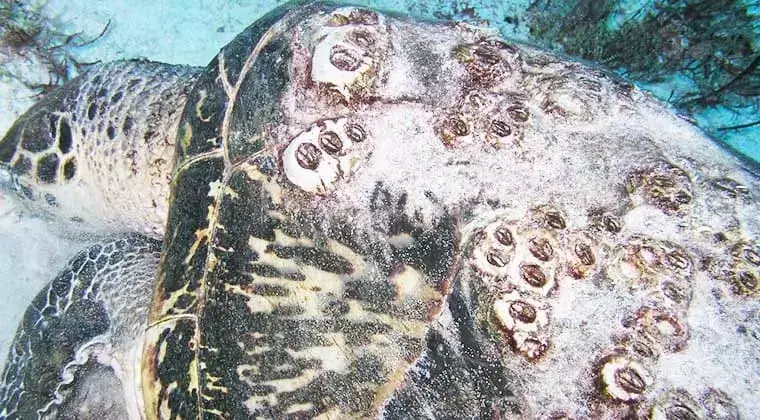Have you ever wondered why turtles are often covered in barnacles? These tiny crustaceans attach themselves to the turtle’s shell, fins, and skin, making it difficult for the turtle to swim and breathe. But why do these barnacles attach to turtles in the first place?
Barnacles attach to turtles as a way of finding a stable surface to live on and filtering food from the water. Barnacles are filter feeders, meaning they catch tiny organisms from the water using feathery appendages called cirri. By attaching themselves to a turtle’s shell, they have a reliable surface to live on while also gaining access to a constant flow of food-rich water.
In this article, we will explore why barnacles attach to turtles, what benefits they provide to each other, and how this unique relationship has evolved over time.
What Are Barnacles?
Barnacles are marine arthropods that belong to the subclass Cirripedia. They have a hard outer shell and several pairs of feathery legs that they use for feeding and reproduction. Barnacles live a sedentary lifestyle, and they attach themselves to a substrate using a cement-like substance secreted by their antennae.
The Relationship Between Barnacles And Turtles
Barnacles and sea turtles have a commensalistic relationship, meaning that barnacles benefit from the association, while turtles are neither harmed nor helped. Barnacles attach themselves to the surface of the turtle’s shell, using it as a substrate for growth and protection. In return, turtles receive no direct benefit from the barnacles but are not negatively impacted.
Why Do Barnacles Attach To Turtles?
The barnacles need a stable surface to live on and filter food from the water. By attaching to a turtle’s shell, barnacles gain a constant flow of food-rich water while also having a reliable surface to live on.
Barnacles attach themselves to turtles for several reasons. Firstly, turtles provide a stable and protected surface for barnacles to grow and reproduce. Secondly, turtles are constantly moving, which means that the barnacles have access to a steady supply of food. Finally, turtles also provide a means of transportation for barnacles, allowing them to disperse to new areas and colonize different habitats.
The Benefits Of Barnacles To Turtles
Although barnacles do not provide any direct benefits to turtles, there are some potential advantages. For example, the barnacles may act as a protective barrier against predators, parasites, and harmful UV radiation.
Additionally, the barnacles may help the turtles to blend in with their surroundings, making them less visible to predators.
The Drawbacks Of Barnacles To Turtles
While barnacles may provide some benefits to turtles, they can also have drawbacks. Barnacle overgrowth can add significant weight to the turtle’s shell, making it more difficult for the turtle to swim and move.
This additional weight can also make the turtle more vulnerable to predation, as it may not be able to move as quickly to escape from predators.
The Impact Of Barnacles On Turtle Populations
Barnacles do not have a significant impact on turtle populations, as they are not harmful to the turtles. However, excessive barnacle growth can impede the turtle’s movement and make them more susceptible to predation, which could have an indirect effect on the population.
Additionally, if a large number of barnacles are attached to a turtle, it may be more challenging to identify the turtle’s species, which could affect conservation efforts.
How Do Barnacles Choose Their Hosts?
Barnacles do not actively choose their hosts but instead attach themselves to any suitable surface that they come into contact with. However, turtles with smoother and less damaged shells are more likely to have barnacles attached to them.
How Do Barnacles Attach To Turtles?
Barnacles attach to turtles using a cement-like substance secreted by their antennae. Once attached, the barnacle undergoes a process of metamorphosis, during which it develops its characteristic hard outer shell.
How To Prevent Barnacle Overgrowth In Turtles
Preventing barnacle overgrowth in turtles is difficult, as it is a natural and harmless process. However, in captivity, turtles can be kept in clean environments to reduce the likelihood of barnacle growth.
Conclusion
Barnacles attach to turtles for various reasons, including protection, food, and transportation. While they do not provide any direct benefits to turtles, they are not harmful and can have some potential advantages. However, excessive barnacle growth can impede the turtle’s movement and make them more vulnerable to predation.
Understanding the relationship between barnacles and turtles is essential for conservation efforts and the management of turtle populations.
FAQs
Are barnacles harmful to turtles?
While barnacles themselves are not harmful to turtles, a heavy infestation can cause irritation and discomfort, which can lead to secondary infections.
Can barnacles survive on land?
No, barnacles require a constant flow of water to survive, as they filter food particles from the water that flows over their feeding structures.
Can turtles remove barnacles?
Turtles cannot remove barnacles themselves, but over time, the barnacles may fall off naturally as the turtle sheds its outer layers of skin.
Do all species of turtles have barnacles attached to their shells?
No, barnacles tend to attach themselves to larger species of turtles that spend a lot of time swimming in open water.
Do barnacles have any benefits for turtles?
While barnacles do not provide any direct benefits to turtles, they may act as a protective barrier against predators, parasites, and harmful UV radiation.
